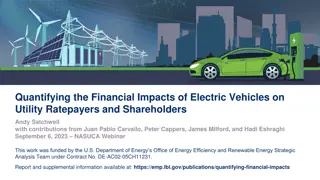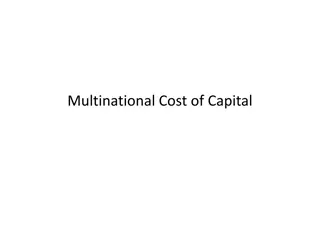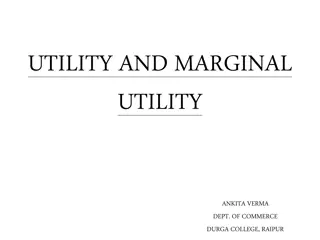
Cost Components of Utility Rate Study
This content discusses the cost components of utility rates, the importance of understanding cost-to-load relationships, time-dependent marginal costs, and methods related to marginal generation capacity costs.
Download Presentation

Please find below an Image/Link to download the presentation.
The content on the website is provided AS IS for your information and personal use only. It may not be sold, licensed, or shared on other websites without obtaining consent from the author. If you encounter any issues during the download, it is possible that the publisher has removed the file from their server.
You are allowed to download the files provided on this website for personal or commercial use, subject to the condition that they are used lawfully. All files are the property of their respective owners.
The content on the website is provided AS IS for your information and personal use only. It may not be sold, licensed, or shared on other websites without obtaining consent from the author.
E N D
Presentation Transcript
TOU OIR Workshop (R.15-12-012) February 26, 2016 Southern California Edison
Cost Components of Utility Rate In general, about half of retail revenues fund variable cost generation generation- -related related activities. The remaining revenues fund more fixed non non- -generation generation services such as distribution and transmission system development and reliability, energy efficiency, demand response, and low income assistance programs. Non Non- -generation generation costs are generally fixed in their nature. SCE intends to study the potential time-dependency of certain distribution marginal costs in its 2016 Rate Design Window Application * Values reflect January 2016 Bundled System Average Rate Levels 3/12/2025 2
Why Costs Matter Understanding the relationship between load levels and corresponding marginal costs is important when determining Time of Use periods (See attached graph) Cost to Load Relationship Historically, customer demand has been the primary driver of the shape and peak of the Utility s Typical or Gross load curve Duck, or Net Load, Curve: Due to the constraints of modelling intermittent supply from renewable resources, the CAISO has chosen to model renewable supply as an overlay on the utility s Typical or Gross load curve Energy Generation Capacity Costs Load The passing of Senate Bill (SB) 350 and implementation of the 50% RPS requirement by 2030 requires that we look beyond 2020 3
Time Dependent Marginal Cost (MC) Overview Marginal Costs Commission has used marginal costs to establish electric utility rates since the early 1980s Embedded costs are the basis of annual revenue recovery for IOU s in California Current scope of Functionalized Marginal Costs Time Dependent based on Time of Use (TOU) periods Marginal Generation Capacity Costs (MCC) Marginal Energy Costs (MEC) Non-Time Dependent Marginal Costs Marginal Distribution costs (EDF in concert with NCP) Marginal Customer Cost (MCC) Transmission costs addressed at FERC level on embedded cost basis NCP Non coincident peak (kW) of a customer EDF Effective Demand Factor - Ratio of customer demand (kW) at the time of circuit peak to the annual NCP 4
Why Costs Matter Marginal Generation Capacity Costs (MCC) Methods Least Cost of Capacity or Peaker Annualized costs based on the least cost capacity option (typically a Peaker) net of energy rents (Most prevalent method used by the IOUs) Differential Revenue Requirements Present value of the difference in generation costs, with and without a load increment Linear programing model A minimum cost model to meet demand given established constraints on the system Valuation Long run Combustion Turbine (CT) Proxy The Duck curve effects on ramp and peak capacity needs will affect the choice of the marginal resource (e.g., Frame 7 vs. aeroderivative vs. combined cycle), which in turn affects MCC Allocation - MCCs and Time of Use Periods MCCs are allocated to time periods based on relative Loss of Load Expectation (LOLE) - the relative probability of an outage in an hour given an event (see attached graph) Capacity need is dependent on the shape and convexity of the load duration curve. The more convex the curve, the more concentrated the allocation of capacity need in those hours. MCCs are the biggest drivers of retail TOU price differentials E3 Heat Map from DR Cost Effectiveness Workshop TBD 5
Why Costs Matter Marginal Energy Costs (MEC) Methods Least Cost Models A simulation of plant dispatch and inter-pool exchanges to meet hourly demands Statistical methods These methods relate market prices to observed factors, which can include both demand side and supply side variables Valuation Day Ahead Price forecast MECs are based on, or modeled to be similar to, the CAISO day ahead (DA) prices. They also include an energy premium for RPS costs MECs are established using a fundamental model that forecasts wholesale energy prices based on a supply and demand characteristics affected by the following constraints: Variable Costs such as Fuel and O&M Renewable energy is must-take and is not dispatchable Operational constraints Allocation - MECs and Time of Use Periods MECs represent the closest proxy to wholesale energy prices that are paid by retail customers They are allocated based on the forecast of expected load by hour (kWh) Concentration of Energy Costs Month Jan 0.02928 0.02829 0.02765 0.02748 0.02866 0.03299 0.03629 0.03839 0.03525 0.03271 0.03309 0.03237 0.03172 0.03033 0.03066 0.03261 0.04167 0.05341 0.05343 0.04536 0.04341 0.03908 0.03648 0.03206 Hour 1 2 3 4 5 6 7 8 9 10 11 12 13 14 15 16 17 18 19 20 21 22 23 24 Feb Mar 0.02560 0.02430 0.02247 0.02336 0.02488 0.02863 0.03375 0.03547 0.02991 0.02494 0.02363 0.02443 0.02510 0.02528 0.02639 0.02635 0.02966 0.03566 0.04296 0.04784 0.04339 0.03847 0.03368 0.02943 Apr May 0.02890 0.02726 0.02614 0.02514 0.02632 0.02979 0.03170 0.02888 0.02204 0.01851 0.01918 0.01970 0.02017 0.01976 0.01998 0.02030 0.02357 0.02734 0.03490 0.04100 0.04889 0.04195 0.03558 0.03095 Jun Jul Aug 0.03160 0.02965 0.02823 0.02740 0.02789 0.02959 0.03122 0.03115 0.02943 0.03051 0.03226 0.03425 0.03654 0.03920 0.04224 0.04498 0.04922 0.04979 0.05024 0.04842 0.04443 0.04103 0.03749 0.03422 Sep Oct Nov 0.02701 0.02600 0.02521 0.02584 0.02745 0.03170 0.03476 0.03096 0.02617 0.02417 0.02330 0.02410 0.02354 0.02337 0.02455 0.02718 0.03384 0.04759 0.04329 0.03703 0.03471 0.03130 0.02995 0.02774 Dec 0.02653 0.02505 0.02445 0.02391 0.02544 0.03140 0.03506 0.03579 0.03118 0.02839 0.02802 0.02809 0.02788 0.02778 0.02766 0.02914 0.03354 0.04199 0.05038 0.04233 0.03989 0.03561 0.03267 0.02970 0.02837 0.02586 0.02429 0.02364 0.02534 0.03112 0.03573 0.03345 0.02489 0.01838 0.01787 0.02011 0.02073 0.02080 0.02130 0.02168 0.02472 0.02942 0.03729 0.04490 0.04849 0.04058 0.03526 0.03102 0.02977 0.02775 0.02691 0.02629 0.02666 0.02862 0.03012 0.02913 0.02720 0.02863 0.03022 0.03240 0.03433 0.03513 0.03705 0.03847 0.04317 0.04500 0.04910 0.05002 0.04809 0.04256 0.03659 0.03314 0.03239 0.02985 0.02913 0.02789 0.02839 0.02975 0.03121 0.03126 0.03075 0.03191 0.03333 0.03469 0.03605 0.03867 0.04118 0.04392 0.04767 0.04837 0.04935 0.04924 0.04704 0.04334 0.03833 0.03511 0.03051 0.02881 0.02747 0.02684 0.02757 0.02940 0.03124 0.03127 0.02939 0.02965 0.03117 0.03300 0.03447 0.03650 0.04074 0.04311 0.04649 0.04801 0.05009 0.05029 0.04350 0.03863 0.03511 0.03278 0.02860 0.02712 0.02564 0.02529 0.02625 0.02881 0.03195 0.03257 0.02952 0.02832 0.02925 0.03061 0.03159 0.03250 0.03390 0.03616 0.03898 0.04496 0.05628 0.04851 0.04011 0.03591 0.03326 0.03083 0.02562 0.02438 0.02369 0.02412 0.02548 0.02970 0.03374 0.03491 0.02878 0.02683 0.02465 0.02440 0.02293 0.02274 0.02369 0.02642 0.03308 0.04503 0.04302 0.03824 0.03590 0.03265 0.03016 0.02689 Concentration of Energy + Capacity Costs Month Jan Feb Mar Apr May Jun 0.02928 0.02653 0.02560 0.02837 0.02890 0.02977 0.02829 0.02505 0.02430 0.02586 0.02726 0.02775 0.02765 0.02445 0.02247 0.02429 0.02614 0.02691 0.02748 0.02391 0.02336 0.02364 0.02514 0.02629 0.02866 0.02544 0.02488 0.02534 0.02632 0.02666 0.03299 0.03140 0.02863 0.03112 0.02979 0.02862 0.03629 0.03506 0.03375 0.03573 0.03170 0.03012 0.03839 0.03579 0.03547 0.03345 0.02888 0.02913 0.03525 0.03118 0.02991 0.02489 0.02204 0.02720 0.03271 0.02839 0.02494 0.01838 0.01851 0.02863 0.03309 0.02802 0.02363 0.01787 0.01918 0.03022 0.03237 0.02809 0.02443 0.02011 0.01970 0.03240 0.03172 0.02788 0.02510 0.02073 0.02017 0.03433 0.03033 0.02778 0.02528 0.02080 0.01976 0.03513 0.03066 0.02766 0.02639 0.02130 0.01998 0.03705 0.03261 0.02914 0.02635 0.02168 0.02030 0.03847 0.04167 0.03354 0.02966 0.02472 0.02357 0.04317 0.05341 0.04199 0.03566 0.02942 0.02734 0.04500 0.05343 0.05038 0.04296 0.03729 0.03490 0.04910 0.04536 0.04233 0.04784 0.04490 0.04100 0.05002 0.04341 0.03989 0.04339 0.04849 0.04889 0.04809 0.03908 0.03561 0.03847 0.04058 0.04195 0.04256 0.03648 0.03267 0.03368 0.03526 0.03558 0.03659 0.03206 0.02970 0.02943 0.03102 0.03095 0.03314 Hour 1 2 3 4 5 6 7 8 9 10 11 12 13 14 15 16 17 18 19 20 21 22 23 24 Jul Aug 0.03160 0.02965 0.02823 0.02740 0.02789 0.02959 0.03122 0.03115 0.02943 0.03051 0.03226 0.03425 0.03654 0.03920 0.12530 0.13369 0.22173 0.36945 0.45984 0.37580 0.37098 0.18246 0.03749 0.03422 Sep Oct Nov 0.02701 0.02600 0.02521 0.02584 0.02745 0.03170 0.03476 0.03096 0.02617 0.02417 0.02330 0.02410 0.02354 0.02337 0.02455 0.02718 0.03384 0.04759 0.04329 0.03703 0.03471 0.03130 0.02995 0.02774 Dec 0.03239 0.02985 0.02913 0.02789 0.02839 0.02975 0.03121 0.03126 0.03075 0.03191 0.03333 0.03469 0.03605 0.03867 0.04118 0.08484 0.08935 0.12833 0.16274 0.12220 0.11979 0.07849 0.03833 0.03511 0.03051 0.02881 0.02747 0.02684 0.02757 0.02940 0.03124 0.03127 0.02939 0.02965 0.03117 0.03300 0.03447 0.03650 0.04074 0.12548 0.21342 0.50865 0.42018 0.42172 0.33550 0.03863 0.03511 0.03278 0.02860 0.02712 0.02564 0.02529 0.02625 0.02881 0.03195 0.03257 0.02952 0.02832 0.02925 0.03061 0.03159 0.03250 0.03390 0.03616 0.03898 0.04496 0.05628 0.04851 0.04011 0.03591 0.03326 0.03083 0.02562 0.02438 0.02369 0.02412 0.02548 0.02970 0.03374 0.03491 0.02878 0.02683 0.02465 0.02440 0.02293 0.02274 0.02369 0.02642 0.03308 0.04503 0.04302 0.03824 0.03590 0.03265 0.03016 0.02689 Blue represents periods of lowest costs; red represents periods of highest costs 6






















